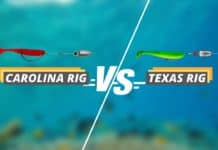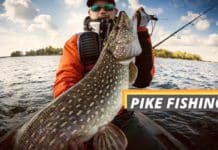Carps are interesting to catch due to their resilience and evasion skills. Keep reading to learn about fly fishing for carp, including when and where to catch these previously considered trash fish.
What Is Fly Fishing for Carp?
Fly fishing for carp is using a weighted fly line to cast carp flies and catch the fish. The most efficient method of carp fishing is drag and drop. However, carp fishing is more challenging than it sounds because carp are strong and evasive. Not to mention that they are easily spooked.
Fun Fact: There are 12 different types of carp. Common carp and mirror carp are the most sought-after types.
One popular tactic is introducing the flies naturally to carp. Another way to increase your chances of catching carp is to practice to ensure an accurate cast.
When to Fly Fish for Carp?
You should fly fish for carp during summer when the water is warm enough to encourage feeding. Since this fish feeds more when it’s dark, the best time to allocate your fly fishing for carp trips is during early mornings, evenings, and nighttime.
If you prefer dry fly fishing, you can do it year-round. However, fly anglers report late summer and early spring as the best seasons for carp fishing.
One rule of dry fishing is that you do it one hour after sunrise or one hour before the sun sets.
On the other hand, wet fly fishing works best late in the summer as the season transitions into fall. The fish tend to move deeper depths into the water column, thus carp anglers’ preference for wet flies.
Where to Find Carp?
You can find carp in freshwater in the Middle East, Europe, and Northern Africa. However, carp are common in freshwaters worldwide.
Since the fish has a high reproductive rate and few predators, they have become problematic in Australia and North America. Furthermore, carp thrive in low-altitude still and slow-flowing waters. Still, carp are well known to survive in different habitats.
Fun Fact: You’re mistaken if you expect this fish to struggle in waters with pollutants or low oxygen levels. Carps survive in the worst habitats and quickly adapt to changes in water conditions.
Here are some of the best spots for fly fishing for carp:
- Brackish waters of coastal lakes and rivers
- Areas with abundant aquatic vegetation
- Ponds
- Man-made habitats, like reservoirs
Fun Fact: Most carp fishing is done through “sight fishing,” which basically means locating carp typically in shallow waters before casting.
What Tackle to Use for Fly Fishing for Carp
Since carp are resilient, strong, and elusive, it’s more crucial than ever to use the correct fly fishing tackle setup. If you are a fly fishing beginner, we recommend getting yourself the best fly fishing book.
Fly Pattern / Carp Flies
Carp are smarter than most fish species. So, don’t expect to catch them on the first try. Fortunately, there are three carp flies that you can use to maximize your chances.
Clouser Swimming Nymph
The clouser swimming nymph is perfect for catching carp in muddy shallow water. It is small yet heavy and has a green and orange pattern to grab the carp’s attention.
Tip: Use the clouser’s swimming nymph with a partly-woven orange or brown thread and a hook size number 6 to 8.
Carp Bitter
Try a carp bitter if you want a more versatile carp fly pattern. Unlike the clouser swimming nymph, you can use it in different waters, including muddy and clear lakes and streams. They are heavy and look disheveled, which is good enough to fool any carp.
Tip: Use these flies with a number 6 hook and brown thread. You can use a fly-tying kit for faster and more convenient fly pattern making.
Headstand Carp Fly
This fly is excellent when you are fly fishing for carp in clear water. Like the clouser swimming nymph, this fly pattern for carp is heavy and small.
As its name suggests, this fly does a headstand when it gets to the bottom of the water, which looks like a small crayfish in a defense position. This presentation is accurate enough to fool a feeding carp.
Tip: Work with a number 8 hook and an olive thread. It gives a more natural look to complement the fly’s material and color patterns.
Fly Rod
Unlike salmon, carp don’t need special rods. However, you must ensure the rods you use are heavy and long.

We recommend 7 or 8-weight rods and 9.5-foot rods to fight aggressive carp. On the other hand, 5 or 6-weight and 9-foot rods are suitable for gentle fly presentation. Regarding the rod type, many anglers prefer fiberglass because it has a slower action speed.
Reel
The reel you choose must match the rod. Preferably go for darker-colored reels since brightly colored ones reflect light in the water, making them conspicuous. In addition, reels with a drag system are best since carp put up an intense fight.
Tip: You can use basic reels but ensure there’s a 30-pound backing. This keeps the carp from snapping the reel and swimming away.
Leader / Tippet

Strong, long leaders should be your go-to option. You should choose those made from fluorocarbon since the material stands out less in the water. Knotless leaders between 9 to 12 feet are highly recommended, whereas the tippet should be between 6 to 15 lbs.
Line
When fly fishing for carp, you should up for a weight-forward line because it can cover all water levels. Moreover, you present the flies gently, even in deep waters. Also, use a line with a light taper because it will quickly turn the fly over without spooking the carp. That said, anglers must stay away from bright-colored lines.
Tip: For faster and easier fishing, use light to moderate tapered lines with natural colors while carp fishing.
Fly Fishing for Carp: The Ultimate Fly
Fly fishing for carp is a fun and thrilling adventure you should try more than once! Just grab the right flies, and gear and head to the waters!
Table of Contents



